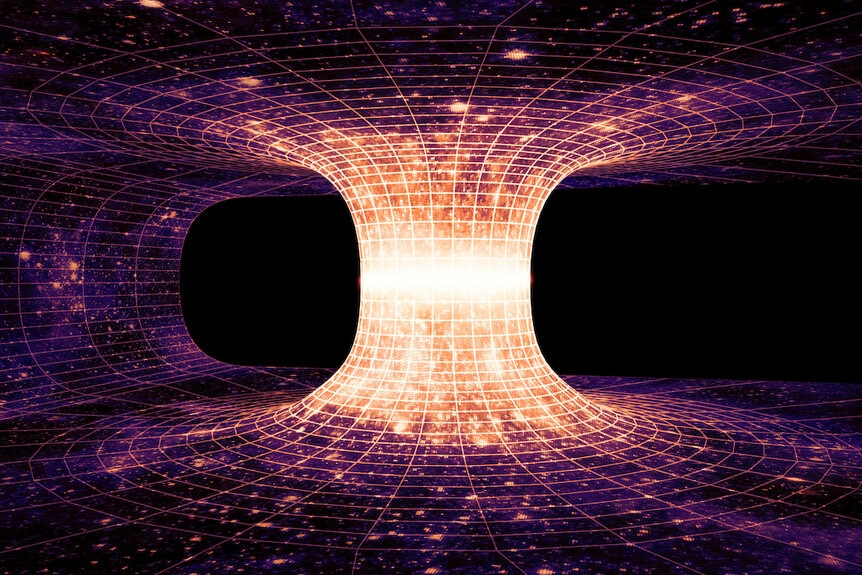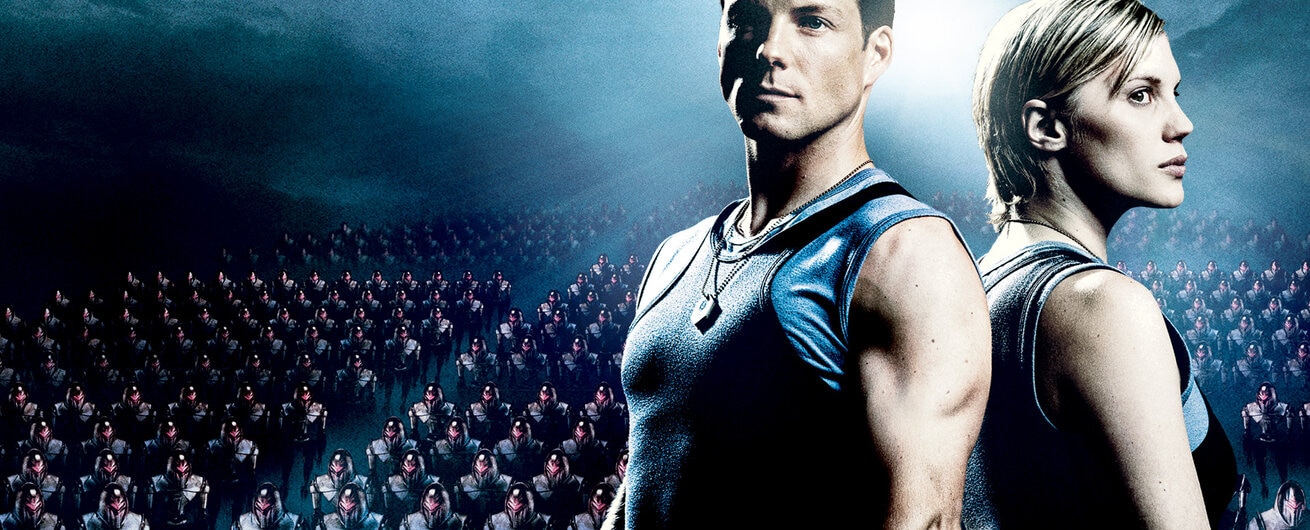Create a free profile to get unlimited access to exclusive videos, sweepstakes, and more!
Have scientists figured out how to make working wormholes?
Try not to think about being destroyed and rebuilt.

The universe is plenty weird already. You don’t have to look far to find incredible star-forming nebulae, ravenous supermassive black holes, and worlds of every imaginable size and type. It seems like every time we point our telescopes at the sky we find something new, but it’s possible that our reality is even weirder than we know.
Science fiction from Farscape to Battlestar Galactica (both of which are streaming on Peacock!) and everything in between, feature at least a mention of wormholes. Fantastical shortcuts through physical space make for a great plot device, but they might not be all that fantastical. Wormholes emerge as possible solutions to Einstein’s theory of general relativity and could hypothetically cut the distance between otherwise distant regions of spacetime. The math checks out, but so far we have yet to see a wormhole either in the lab or existing in nature.
All of that might be primed to change, according to Hatim Salih, an honorary fellow at the University of Bristol’s Quantum Technology Enterprise Center. In a paper recently published in the journal Quantum Science and Technology, Salih proposes a new kind of exchange-free quantum computer which relies on the presence of local wormholes.
RELATED: If you flew your spaceship through a wormhole, could you make it out alive? Maybe…
The process shares a few things in common with existing quantum teleportation techniques, but with one important distinction. Quantum teleportation requires having two particles which are already entangled. Then those particles must be transported so that you have one at the starting position and one at the end. When the sender makes a measurement the particles at both ends are changed and information can be transmitted seemingly instantaneously. That’s the moment of teleportation in quantum teleportation. To decode the information, information must again be shared between the sender and receiver. That means that information carriers (whether particles or people) must travel across the communication channel once at the beginning and once at the end of transmission, in order for it to work.
Salih’s proposed exchange-free quantum computer would do away with the need to entangle particles in advance or communicate after the fact. That, according to Salih, is the punchline, but we need to actually build one of these machines and see if it will actually work.
“I’m a theorist; I almost never go into labs. What I do is work with theories and design plausible experiments. So far, thankfully, there is a good track record of those experiments making their way to the lab and working the way they’re supposed to,” Salih tells SYFY WIRE.
Because Salih’s process is fundamentally different from existing quantum teleportation, he’s given it a new name: counterportation. The proposed machine relies on a series of nested interferometers — machines capable of making incredibly precise measurements by comparing the commute time of nearby lasers — to bounce particles around and transmit information. While typical communication technologies require physical particles traveling across the communications channel (think photons moving down a fiber optic cable), Salih’s machine appears to be capable of sending information across the channel without any actual photons making the journey. We can make sure of that through an investigative technique known as weak measurement, which allows scientists to look at quantum behavior without disturbing it very much.
Any time you measure something, you necessarily change the thing you’re measuring. Drop a thermometer into a pot of hot water and the presence of the thermometer changes the temperature of the water a little bit. There’s no way for you to measure the temperature of the water in the absence of the thermometer, but the two values are so close together that it doesn’t matter most of the time. When you’re measuring things at the quantum level, however, that ceases to be the case. Suddenly, the act of measuring a thing actively changes the thing to such a degree that you can never quite get your hands around it. That’s where weak measurement can come in.
“In a nutshell, if you vibrate the mirror at a certain frequency and look at the counterported object, if that frequency doesn’t appear then you will know it hasn’t touched the mirror. If you repeat the experiment many times, you can see that signature,” Salih said.
The idea is to reduce the impact of measurement as much as possible to minimize any disturbance to the system. The other side of that coin, of course, is that your measurements are equally weak. Because you’ve designed a detector which intentionally avoids interaction, a lot of potential information is missed but you leave the system mostly intact. Think of your particle as a mystery dessert. It could be cake or it could be pie. In a normal experiment, you figure out which dessert you have by sticking your hand in it (looking at it and measuring it). It’s a good way to figure out if you have pie or cake, but you’ve sort of ruined dessert in the process. Weak measurement is more like smelling the dessert as it comes out of the oven, maybe swiping your finger across it to see if it has crust or frosting. You don’t get as much information, but you also don’t disturb your party guests. That’s how you make sure your device works as intended.
“Then we can verify no information carriers cross the channel. Once we establish that firmly, we can start asking all sorts of interesting questions. The most glaring one is, ‘What the hell?’” Salih said.
RELATED: Where is the cast of SYFY's ‘Farscape’ now? Ben Browder, Claudia Black & more
When information moves from one place to another, one of three things must be true. The first is that photons are moving across space, like the aforementioned photons in a fiber optic cable. The second is a remote measurement of some non-optical phenomena. If you’re getting information from somewhere, there’s a good chance that you’re getting it through one of these two means, but there is a third possibility. “The third means is what is called an underlying physical reality. Because counterportation is deterministic, in the sense that the counterported object would match the original, counterportation fits the bill of an underlying physical reality,” Salih said.
The bottom line is information has to get from one place to another either through some measurable mechanism or because something in the fundamental reality of the universe allows it to. That’s the basic premise behind the idea of Constructor Theory, which thinks of physics in terms of what is possible and what isn’t. If counterportation is possible, as Salih’s paper seems to suggest, then there must be some underlying physical phenomena to facilitate it. Enter: local wormholes.
“When an object is reconstituted across space without anything passing, that’s clearly reminiscent of what a reversible wormhole does. You have an entrance and an exit and no observable journey from outside the wormhole. So, kind of intuitively, this is a wormhole,” Salih said.
Salih imagines an exchange-free quantum computer being built sometime in the next few years. While it would constitute a new type of instrument, it could be constructed using existing technologies currently in use in other scientific settings, according to Salih. Once constructed, counterportation might open up new paths of discovery, allowing scientists to probe into some of the weirdest and most counterintuitive parts of the universe’s operating system. That’s something Salih hopes will be a global effort, with scientists and hobbyists all over the world getting remote access to local wormholes and counterportation experiments.
“A lot of times, you perform the experiments, write the paper, and the instruments get dismantled. We would want such a setup to be somewhere permanently and linked to researchers and hobbyists. Emphasis on physics hobbyists, I started like that,” Salih said.
Assuming the machine gets built and works as described, the first counterported objects will likely be something on the scale of atoms, but Salih says that might only be the beginning.
“In the paper, we’re counterporting a trapped atom coding a qubit. But, here’s the thing, if you have a more complex quantum object made of a network of these atoms, which could be entangled, and you counterport each of the atoms, then you will have counterported the whole network. It’s scalable that way,” Salid said.
But there are also some limitations. Counterportation happens at a fraction of the speed of light, requires equipment at both the sending and receiving location, and must have line of sight. While no actual photons are being exchanged across the channel, counterportation depends on the possibility that a photon could have made the journey. Don’t zip up your jumpsuit and prepare for interstellar adventures in deep space just yet, exchange-free travel through wormholes turns out to be the sort of thing you literally have to see to believe.
Run through wormhole dress rehearsals in Farscape and Battlestar Galactica, streaming now on Peacock!




























